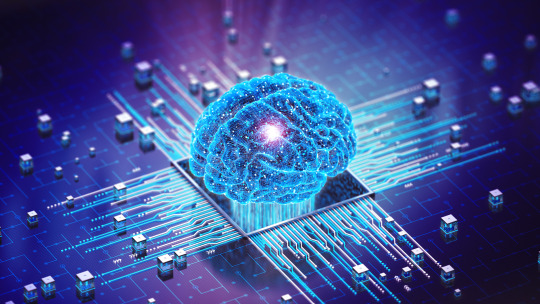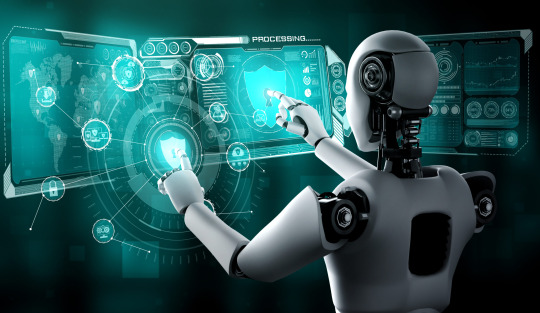Don't wanna be here? Send us removal request.
Text
How AI Tools Are Changing the Future of Graphic Design

The world of graphic design is undergoing a transformation like never before. While creativity and human touch have always been at the heart of design, the rise of artificial intelligence is adding a powerful new dimension to this field. What once took hours or even days of manual effort is now being enhanced and accelerated by smart algorithms that can generate, modify, and adapt visuals in seconds. For designers, this doesn’t mean replacing their creativity—it means expanding it.
In the past, designers relied heavily on a handful of tools and their own artistic intuition to bring ideas to life. But now, AI-powered platforms are making it possible to automate repetitive tasks, experiment with styles, and produce high-quality graphics with astonishing speed. This doesn’t just help designers save time—it empowers them to think bigger and push their creative boundaries further than ever before.
Imagine being able to generate dozens of logo variations instantly, or seeing how different color palettes would affect your layout with just a click. These capabilities are no longer futuristic—they’re available now, thanks to AI-driven software that learns from data and makes intelligent suggestions based on design principles, user behavior, and even current trends.
AI tools can now assist in creating mood boards, resizing assets for various platforms, cleaning up images, and enhancing photo quality without the need for complex manual editing. Some tools even help with accessibility by automatically adjusting contrast ratios or ensuring legibility for all users. The result is a more streamlined, efficient process that still leaves room for a designer’s unique style and voice to shine through.
The beauty of AI in graphic design lies in how seamlessly it integrates into creative workflows. Instead of replacing human designers, it acts more like a smart assistant—offering suggestions, predicting needs, and performing the heavy lifting of tasks that used to take up valuable time. This means designers can now focus more on concept development, storytelling, and innovation, rather than spending hours resizing banners or aligning elements pixel by pixel.
Midway through this transformation, many professionals are realizing the importance of adapting to this new creative ecosystem. Whether you're an independent designer or part of a larger agency, it's essential to understand how these tools can benefit your work. That’s why exploring AI tools for visual design can be a game-changer in how you approach every project from now on.
Some of the most popular tools are those that use machine learning to generate layouts, select typefaces, or even compose social media content. These platforms analyze massive amounts of design data to recognize patterns and preferences, allowing them to suggest optimized designs for your audience or brand. For marketing teams, this can translate into faster campaign execution and more targeted visuals that perform better across different channels.
Even more intriguing is the emergence of AI-generated art. Tools like DALL·E, Midjourney, and other image synthesis technologies have made it possible to create highly detailed, surreal, or hyper-realistic images from simple text prompts. This opens up entirely new creative territories for those who are willing to experiment and collaborate with machines as part of their artistic process.
Of course, there are concerns about AI in design, particularly around authenticity and originality. Some critics argue that machine-generated content could dilute the value of true creativity, or that it might lead to a flood of generic visuals. But in practice, these tools are most effective when used as partners in the design process, not as replacements. The human element—your intuition, emotion, and personal experience—remains irreplaceable.
As the industry continues to evolve, the role of the designer is also shifting. No longer just visual artists, today’s designers are becoming creative technologists—skilled in both the aesthetics of design and the logic of data and algorithms. This fusion of art and tech is giving rise to a new generation of professionals who can create stunning visuals while understanding how those visuals perform, adapt, and resonate in a digital world.
Education is already catching up to this shift. Design schools are beginning to introduce courses on AI-assisted creativity, teaching students how to work with these tools from the ground up. At the same time, industry leaders are sharing insights on how to integrate AI into everyday workflows while maintaining a strong design philosophy. The goal isn’t to teach machines how to be creative—it’s to teach creatives how to use machines.
What this all points to is a more dynamic and inclusive future for design. By lowering technical barriers and speeding up production, AI allows more people to participate in the creative process—regardless of whether they’ve been formally trained. This democratization of design means fresh voices, bolder ideas, and more diversity in the visuals we see and engage with every day.
In the coming years, we’ll likely see even more personalized design experiences, where AI can tailor visuals in real-time based on user preferences or interaction patterns. Designers who embrace this future will find themselves not only more efficient, but more empowered to do what they do best: tell stories that move people.
So whether you're skeptical or excited, one thing is certain—AI is not just a trend in graphic design. It's a shift in the very foundation of how we create, share, and experience visual content. Embracing these tools today could be the key to staying relevant and thriving in a design world that's changing faster than ever before.
0 notes
Text
Top 5 AI Tools for Effortless Visual Design

In today’s fast-moving digital world, visual content isn’t just an accessory—it’s the heartbeat of effective communication. Whether you're a solo entrepreneur, a social media manager, or a graphic designer juggling tight deadlines, finding ways to create stunning visuals quickly and easily is more essential than ever. That’s where artificial intelligence steps in, revolutionizing the design space and making professional-level graphics accessible to everyone, regardless of their technical skills.
Artificial intelligence isn’t just automating tasks anymore—it’s becoming a collaborative partner in the creative process. Visual design, once the exclusive domain of Adobe masters and trained illustrators, is now open to anyone willing to explore the right AI tools. But with so many platforms promising magical results, it can be overwhelming to know where to start. That’s why we’ve narrowed it down to the top five AI-powered tools that are actually delivering on their promises and helping creators design smarter, not harder.
One of the biggest game-changers in this space is Canva. While it's already a household name for drag-and-drop design, Canva’s integration of AI has taken things up several notches. Its “Magic Design” feature allows users to input a prompt or an image, and the tool generates multiple design variations in seconds. Whether you're crafting social media graphics, presentations, or even marketing brochures, Canva’s AI speeds up the ideation phase, allowing you to refine rather than start from scratch. It’s especially helpful for non-designers who need polished results without the learning curve.
Next on the list is Adobe Firefly, Adobe’s own AI design assistant. Firefly is seamlessly embedded into the Creative Cloud ecosystem, giving longtime Adobe users a familiar environment with a futuristic twist. It can generate images from text, apply styles automatically, and even understand complex art direction based on a few descriptive keywords. What makes Firefly stand out is its quality—Adobe hasn’t cut corners in image resolution or editing precision. This tool is ideal for professionals who still want full control over their design output but with AI as a supercharged assistant.
Another standout is Looka, an AI-driven branding platform that’s perfect for startups and small businesses. With Looka, you don’t just get design support—you get an entire brand identity package. Just enter your company name and a few style preferences, and it generates logos, color palettes, business card layouts, and more. It’s an all-in-one solution for anyone building a brand from the ground up without hiring a designer. Looka’s AI does more than make suggestions; it understands cohesive design systems and helps you build a professional visual identity in minutes.
Let’s not forget about Uizard. While many tools focus on static images, Uizard is all about UI and UX design. It turns hand-drawn wireframes into fully interactive digital prototypes. This is a massive time-saver for developers, product managers, and UX designers who need to test ideas quickly or present concepts without waiting for full mockups. It also includes AI-generated design suggestions, automatically adjusts layouts, and supports real-time collaboration. For app and web developers, Uizard is more than a helper—it’s a core part of the creative process.
Before we get to the final tool, it’s worth taking a moment to acknowledge the growing trend of integrating AI tools for visual design into everyday workflows. These tools are no longer optional for teams that want to stay ahead. They're now essential assets, helping creators bring ideas to life faster, test more versions, and deliver content that meets the demands of today’s fast-scrolling audiences.
Rounding out our list is Designs.ai, a platform that truly lives up to its name. It offers a full suite of creative tools—logo makers, video editors, voiceover generators, and design assistants—all powered by AI. What’s most impressive about Designs.ai is its intuitive interface. You don’t need to dig through menus or watch endless tutorials to get started. Just feed the AI your goals, and it starts building. It’s perfect for marketers who need a quick turnaround and consistent branding across multiple content types.
The exciting thing about all these tools is how accessible they make visual creativity. You no longer need to be fluent in Photoshop or spend hours tweaking fonts and filters to get the result you want. AI is democratizing design, opening doors for people who have ideas but not necessarily the technical skills to execute them. Whether you're building a brand, launching a product, or just creating eye-catching content for your blog or social feed, these tools put high-quality design within reach.
What’s more, AI in design isn’t just about speed. It’s about inspiration. Sometimes the hardest part of any creative project is just getting started. These tools give you a starting point, generate ideas you hadn’t considered, and evolve as you work with them. It’s a dynamic relationship, one that encourages exploration instead of just automation.
Of course, AI is not without its limits. It still benefits from human intuition, taste, and storytelling. But think of it this way: AI handles the heavy lifting so you can focus on the spark that makes your design truly unique. That combination—human vision with machine precision—is what makes this moment in visual design so exciting.
If you're serious about creating standout content without spending endless hours learning complicated software, it’s time to explore these tools and see what they can do for you. They’re fast, smart, and constantly evolving. And the best part? You don’t need a big budget or a design degree to make them work. You just need a vision and the willingness to experiment.
In the end, effortless design doesn’t mean thoughtless design. It means having more time to focus on the message, the emotion, and the connection you want to create. These AI tools are your creative allies—ready when you are.
1 note
·
View note